Residential electricity prices for first half of 2017 up 3 percent over 2016

Retail electricity prices for residential customers averaged 12.8 cents per kilowatt-hour (kWh) in the first half of 2017, a 3 percent increase over 2016 rates.
Rates were higher in most areas of the United States. Only six states experienced a decrease in rates.
The rising cost of fuels such as natural gas contributed to the increase in rates. The cost of natural gas delivered to electric generators in the United States was 37 percent higher in the first six months of 2017 than during the same period in 2016. An increase in spending by utilities on infrastructure also contributed to the increase.
A decrease in electricity usage balanced out the higher rates, keeping the average residential electricity bill at around the same cost in 2017 as in the year prior. During the first half of 2017, the average residential electricity bill cost $104.
In the first half of 2017, the average residential customer consumed approximately 812 kWh each month, a 2.5 percent decrease from the first half of 2016. This is due in large part to warmer winters and cooler summers, reducing the need for heating and cooling.
The U.S. Energy Information Administration’s (EIA) Short-Term Energy Outlook predicts that 2017 electricity rates will remain higher than 2016 rates for the rest of the year. The annual average is expected to be 3.6 percent higher than in 2016. EIA forecasts that the average U.S. residential customer will spend $1,350 on electricity this year, almost exactly the same amount as the previous year.
